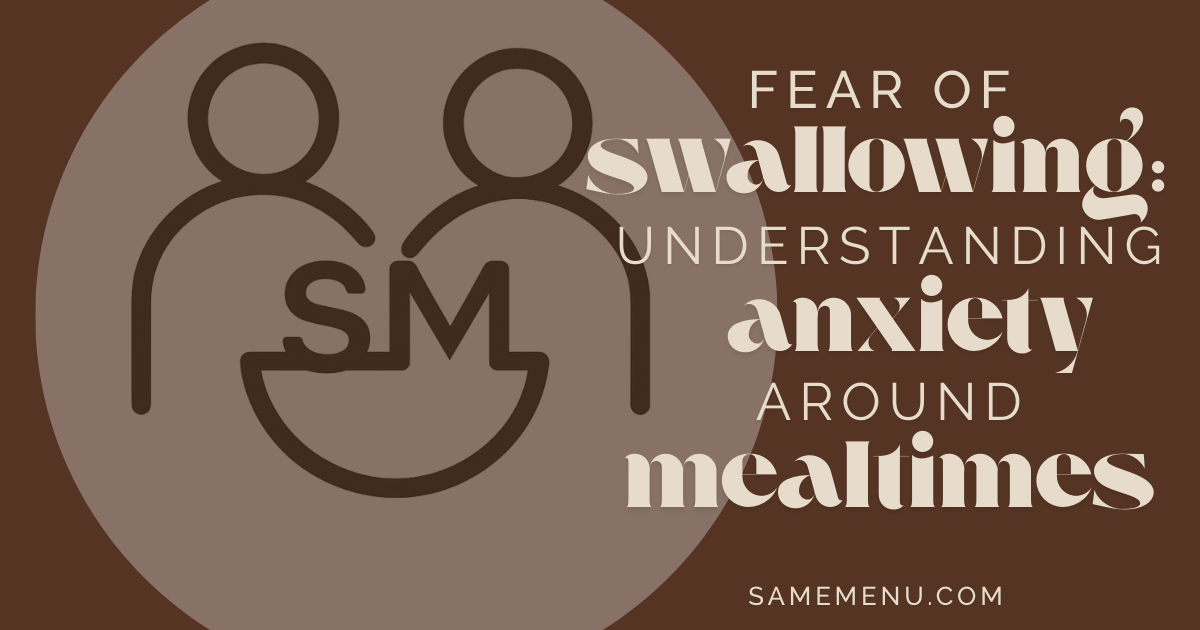Fear-based swallowing difficulties don’t appear out of nowhere. They’re learned. Maybe anxiety heightened your focus on the mechanics of eating, making every movement in your throat feel unnatural, exaggerated, or risky. Maybe you’ve started avoiding certain foods, textures, or entire meals just to sidestep the anxiety.
If any of this sounds familiar, know that you’re not imagining it, and you’re not alone. This fear is real, and just as your brain learned to associate swallowing with danger, it can also learn to recognize it as safe again.
What is Fear of Swallowing?
Sometimes called pseudodysphagia or phagophobia, a fear of swallowing can be described as “I’m afraid I’ll choke if I eat” or “swallowing feels inadequate”. It is essential when you notice a change in your safety while eating and drinking, you schedule an appointment with you primary care physician to help with making a referral to an Ear, Nose, and Throat doctor or a Speech-Language Pathologist (expert in swallowing rehabilitation). While dental, muscular and neurological changes can change the way that we safely chew and swallow foods and drinks, pseudodysphagia is often diagnosed when a client has received testing to rule out these physiological causes. This isn’t weakness or “made up”; it’s a learned fear response. At this time, your brain is pairing eating your meals with danger. The good news: fears that are learned can also be unlearned.
Why it Feels So Overwhelming
When anxiety takes over, it can make normal throat movements feel strange or even threatening. You may notice every tiny sensation, from the tongue pushing food back to the throat muscles tightening, and interpret those normal actions as exaggerated or risky.
It’s also common to start avoiding foods that feel difficult to swallow, maybe breads or rice that seem “sticky” or meats that can never be chewed enough or even to skip entire meals. Avoidance brings short-term relief, but it teaches the brain that the only way to stay safe is to keep avoiding, which reinforces the fear. Over time, this creates a cycle: anxiety leads to muscle tension, the tension makes swallowing feel harder, and the harder it feels, the stronger the fear becomes.
Cognitive behavioral therapy (CBT) is one of the most effective approaches for fear based conditions like pseudodysphagia. One part of CBT is learning to notice the anxious thought (“If I swallow, I may cough”) and replacing it with something more balanced, such as “I have swallowed safely thousands of times; this feeling is anxiety, not danger.” It may feel forced at first, but over time this kind of reframe chips away at the automatic link between swallowing and fear.
Another CBT strategy is gradual exposure. Instead of avoiding feared foods completely, you start small with items that feel safe (smooth yogurt, soft pasta, or well-cooked vegetables) and take calm, intentional bites. As your comfort grows, you slowly add in more challenging foods in very small amounts. Each safe swallow becomes evidence that helps retrain your brain.
Practical Tips You Can Try Today
Start by choosing supportive textures. Many people find it easier to begin with foods that are naturally smooth, moist, and easy to swallow, such as smoothies, pudding, or blended soups. These textures provide a sense of safety and let you focus on the act of eating without extra effort. As your comfort builds, you can expand outward, but there’s no harm in leaning on safe foods as part of the process to stay nourished.
The environment matters too. Eating in a calm, unhurried setting can make a big difference. Turn off distractions that raise your stress level and give yourself permission to eat slowly. For some, conversation or songs can help people find some “positive distraction”, but be aware of not talking while chewing or swallowing a bite. Even simple changes, like sitting upright at a comfortable table rather than standing or rushing in the car, send your body the message that you’re safe.
Mindful pacing is another tool. Before you start eating, pause for two or three slow breaths that expand the belly rather than the chest. Try to double the length of the exhale compared to the inhale. This lowers tension in the throat and chest and helps encourage relaxation. During the meal, put your fork or spoon down between bites. That tiny pause helps your nervous system reset and reminds your body that it doesn’t need to rush.
Some people also benefit from using a short phrase as a grounding tool. Whispering or thinking something like “safe and steady” before taking a bite creates a cue that can interrupt the anxiety spiral. Over time, your body starts to associate the phrase with calm eating, making it easier to repeat the behavior in future meals.
Finally, it helps to keep track of your progress. Write down what foods you managed, how the meal went, or even how long you stayed at the table. Looking back over a week or two, you may notice small but steady improvements that are easy to overlook in the moment. Those little wins reinforce the idea that change is possible.
When to Reach Out for More Help
If fear of swallowing leads you to skip meals, lose weight, or avoid eating around others, professional support can make recovery faster and safer. Speech-language pathologists and therapists familiar with anxiety can provide structured guidance, blending safe swallowing strategies with proven anxiety management techniques.
Moving Forward
Fear of swallowing can feel isolating, but it’s more common than you might think, and it’s not permanent. By practicing mindful pacing, choosing supportive foods, and reframing anxious thoughts, you can begin to rebuild trust in your ability to eat and swallow safely. Each calm meal is not just nourishment for your body; it’s a step toward reclaiming comfort and confidence at the table.
Continue Reading
Check out the full collection of easy to chew and swallow recipes here.
Keep up with other guides and resources for the dysphagia community.

Leave a Reply